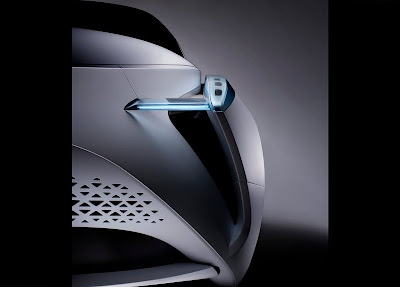 |
| 2012 Toyota FT-Bh Review, Performance and Specs |
According to Toyota, the lightweight FT-Bh will pack a full hybrid powertrain, which is pretty obvious considering that it’s a concept for the future and thus, possesses materials and techniques that are being developed for use on the company’s future vehicle line-up.
If what Toyota tells us about the FT-Bh is true, it's not some futuristic fantasy, but a design study that points to what a next generation Yaris hybrid might look like. With an unbelievably low, sub-1,800-pound curb weight and a 0.235 coefficient of drag, the FT-Bh uses minimalist design rather than sci-fi technology to achieve 112 miles per gallon. The FT-Bh packs a two-cylinder, one-liter gas engine that runs on the Atkinson cycle, and uses lithium-ion batteries for it's hybrid drive system. Toyota says a compressed natural gas hybrid and a plug-in hybrid version would also be possible.
But what's really impressive about the FT-Bh is its massive weight reduction. Toyota says it managed to reduce the mass of the car by 25 percent when compared to the current Yaris. Much of that came in the interior parts and trim, which weigh half that of the production car. Toyota says that this drastic diet also makes possible a low center of gravity – just over 21 inches – that helps improve the FT-Bh's handling.
While the FT-Bh may look a little weird – we're reminded of how odd the Prius looked before we'd gotten used to the shape – this may well be what the next generation of hybrids will look like. While Toyota has thrown out some branding buzzwords to describe the FT-Bh's "Ecomotion" theme (or is that "Under Priority" design language? or "Keen Look" styling?) the bottom line is that it's all about aerodynamics. This is why the FT-Bh uses cameras rather than side-view mirrors and doesn't have door handles. It's also why the front end has those "air curtain" intakes and there's an underfloor spoiler in the rear.
Review Exterior of 2012 Toyota FT-Bh Concept :
We fully understand the concept nature of the Toyota FT-Bh Concept, but it does makes us wonder if this car’s look was penned as an inside joke within the company. With all due respect to the bullet-shaped body, the merging long roof, the protruding windshield, and the narrow pillars, but the one thing that we can’t get out of our heads is that it looks like a hamster.
The overall design of the FT-Bh Concept was inspired by Toyota’s "Keen Look" styling, which can look really good on a coupe concept like the Lexus LF-Lc, but not on a little compact concept like the FT-Bh. Even the concept’s vertical front lights that have been integrated into the fenders and the low grille placement doesn’t add much to the appeal of the car.
The vehicle’s dimensions - 3,985 mm long, 1,695 mm wide, and 1,400 mm tall with a wheelbase of 2,570 mm - makes for a really small city car and thus, contributing to the car weighing only 786 kg.
Review Interior of 2012 Toyota FT-Bh Concept :
On the other hand, the interior of the FT-Bh looks pretty impressive. As a concept, you kind of expect to see something completely futuristic and the FT-Bh doesn’t disappoint. The overall design features air zoning while also expressing an emotional design that manifests itself through the "tensional force" of tautly stretched fabric. For a small city car, the concept surprisingly has room for four "ultra-thin shell seats". Likewise, the leather upholstery on the interior uses light and breathable materials while the center display located deep in the dashboard comes with plenty of technological features, including rear views from three body-mounted cameras, and a rear-view mirror that has its own ambient superimposed display6 that provides information and warnings concerning vehicles reflected in the mirror and also other driver-targeted information.
Review Powertrain of 2012 Toyota FT-Bh Concept :
As a concept powered by a gasoline-electric hybrid powertrain, the FT-Bh doesn’t have any illusions when it comes to being a high-powered speed demon. Instead of the thrills, the concept prides itself on being the ultimate ride of efficiency. It’s powered by a 1.0-liter, two-cylinder THIS II gas engine and combined with a lithium-ion battery to provide - according to Toyota - "high environmental performance with CO2 emissions of only 49 g/km under the NEDC, along with improved hybrid system efficiency."
The FT-Bh targets CO2 emissions which are less than half those of the current 1.0 litre Yaris. But only through the mass-production of an affordable ultra-low emissions vehicle can sales volumes be large enough to make a genuine contribution to the real world reduction of total vehicle CO2 emissions on a global scale.
Aimed, therefore, at maximum affordability, the techniques and thought processes demonstrated in the concept’s design do not involve the use of exotic, expensive materials or complex procedures, but only those already commonplace to the automotive industry.
Reviewer: Neo Anderson
Item Reviewed: 2012 Toyota FT-Bh Review, Performance and Specs
Item Reviewed: 2012 Toyota FT-Bh Review, Performance and Specs
Posted by: Neo Anderson
The Latest Car, Updated at: 11:10 PM
Title: 2012 Toyota FT-Bh Review, Performance and Specs
Rating: 100% based on 99999 ratings. 99999 user reviews.
Review by Neo Anderson
Thank you for your visit with your willingness to read our article. Suggestions you can convey through the comment box below! ... ^ _ ^
Rating: 100% based on 99999 ratings. 99999 user reviews.
Review by Neo Anderson
Thank you for your visit with your willingness to read our article. Suggestions you can convey through the comment box below! ... ^ _ ^












{ 0 comments... Views All / Send Comment! }
Post a Comment